Abstract
In patients with an autosomal recessive diamino acid transport disorder, lysinuric protein intolerance (LPI), we measured plasma and urinary amino acids basally, and during intravenous infusion of citrulline at two rates. Compared with controls, the patients' plasma citrulline concentrations rose similarly, but urinary citrulline excretion increased excessively. Their plasma arginine and ornithine levels rose subnormally, but massive argininuria and moderate ornithinuria appeared. The excretion rates of the third diamino acid lysine and other amino acids remained practically unaltered, thus excluding mutual competition as the cause for the increases. The results suggest that (a) in the normal kidney reabsorption involves partial conversion of citrulline to arginine and ornithine (metabolic run-out), (b) in LPI, the diamino acid transport defect is located at the basolateral cell membrane of the renal tubules; this inhibits the efflux of arginine and ornithine, increasing their cellular concentration, which in turn inhibits the metabolic disposal of citrulline, and causes leakage of arginine, ornithine, and citrulline into the tubular lumen.
Full text
PDF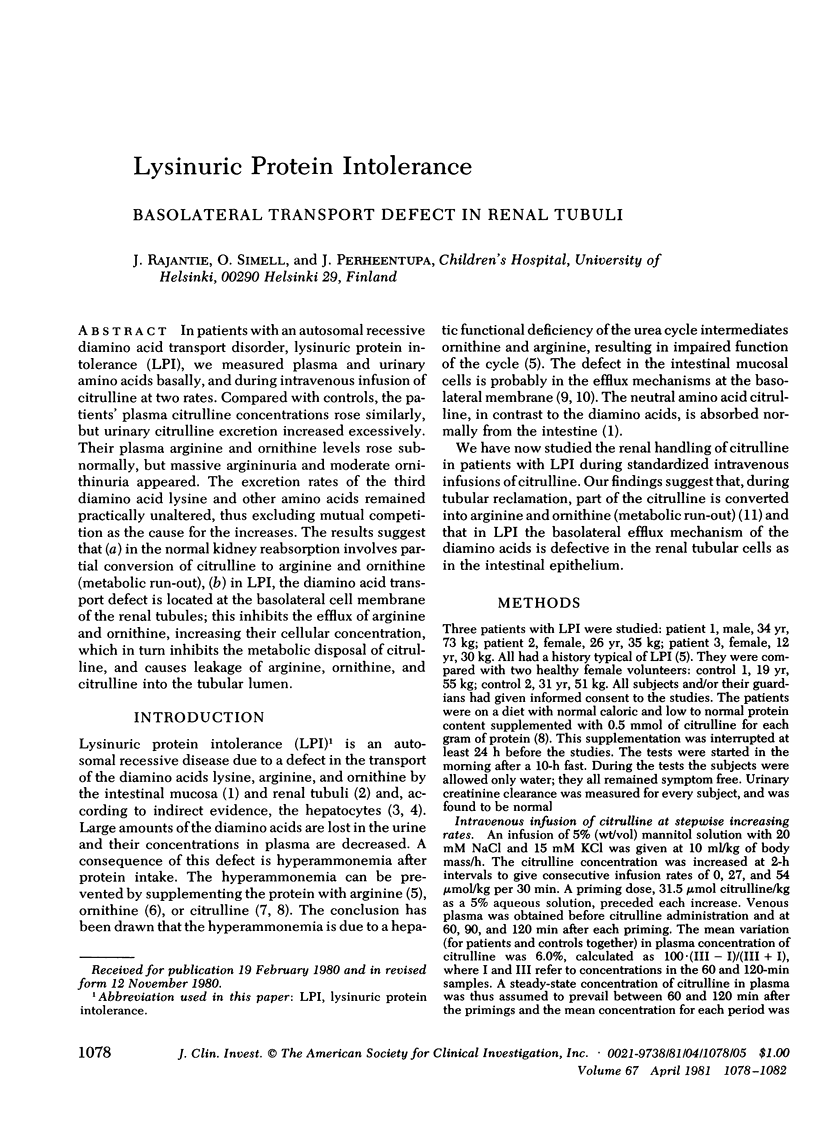
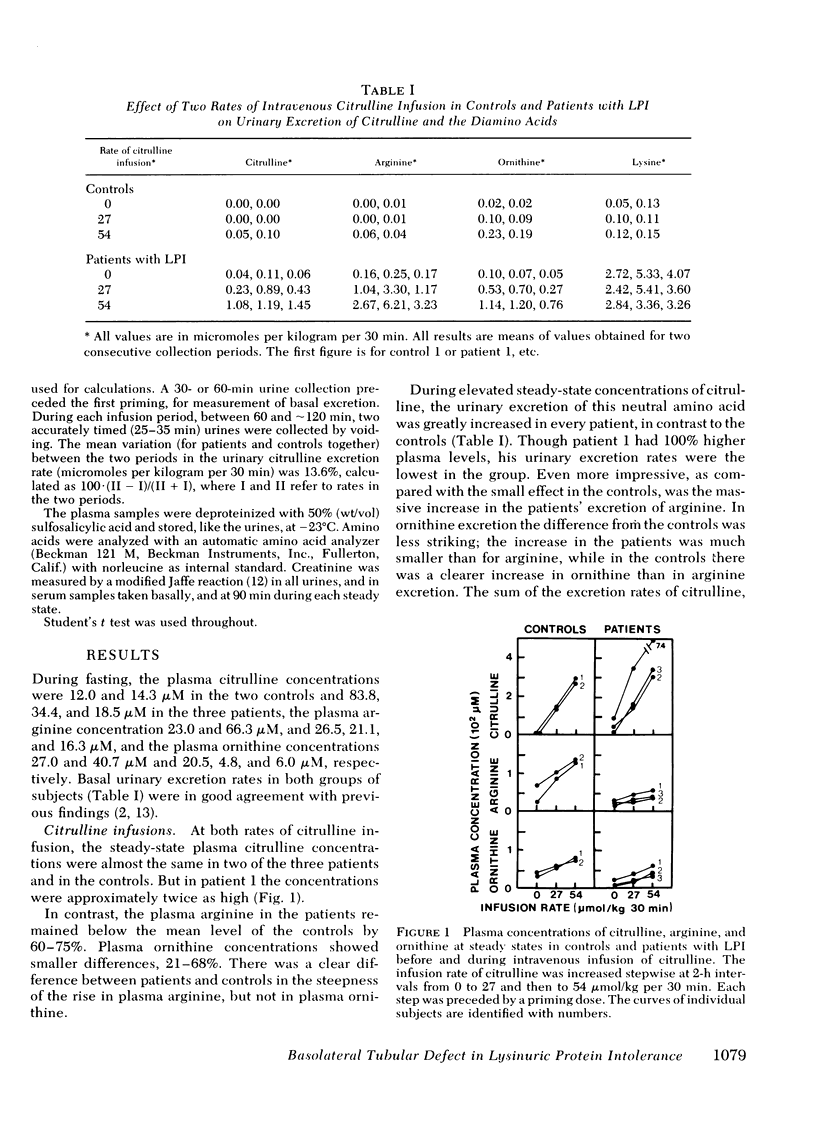
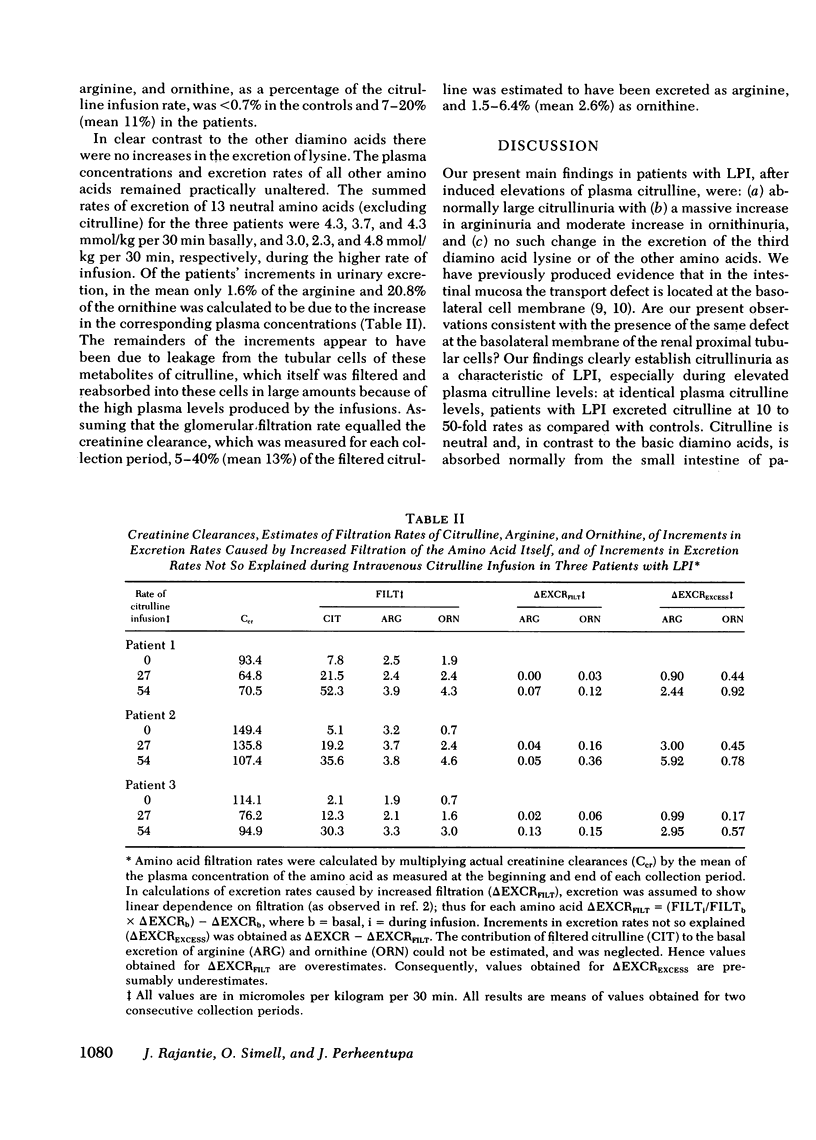
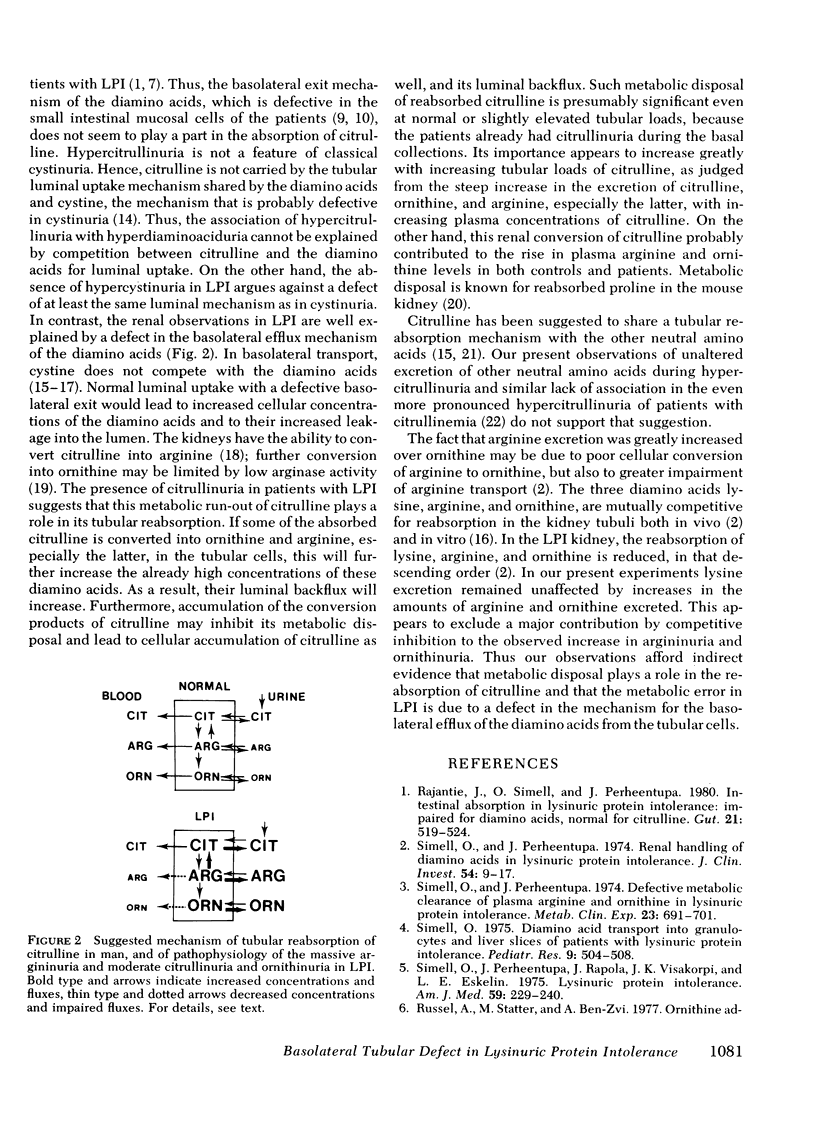
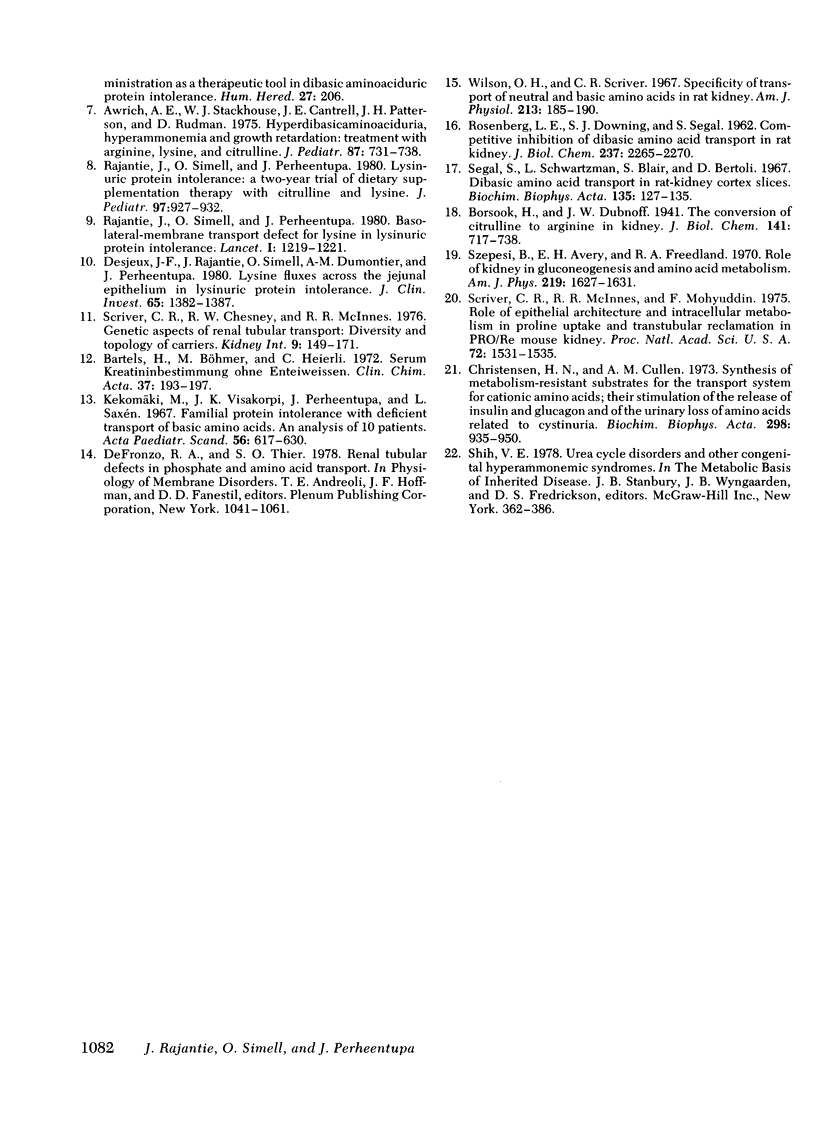
Selected References
These references are in PubMed. This may not be the complete list of references from this article.
- Awrich A. E., Stackhouse W. J., Cantrell J. E., Patterson J. H., Rudman D. Hyperdibasicaminoaciduria, hyperammonemia, and growth retardation: Treatment with arginine, lysine, and citrulline. J Pediatr. 1975 Nov;87(5):731–738. doi: 10.1016/s0022-3476(75)80296-4. [DOI] [PubMed] [Google Scholar]
- Bartels H., Böhmer M., Heierli C. Serum Kreatinibestimmung ohne Enteiweissen. Clin Chim Acta. 1972 Mar;37:193–197. doi: 10.1016/0009-8981(72)90432-9. [DOI] [PubMed] [Google Scholar]
- Christensen H. N., Cullen A. M. Synthesis of metabolism-resistant substrates for the transport system for cationic amino acids; their stimulation of the release of insulin and glucagon, and of the urinary loss of amino acids related to cystinuria. Biochim Biophys Acta. 1973 Apr 16;298(4):932–950. doi: 10.1016/0005-2736(73)90397-0. [DOI] [PubMed] [Google Scholar]
- Desjeux J. F., Simell R. O., Dumontier A. M., Perheentupa J. Lysine fluxes across the jejunal epithelium in lysinuric protein intolerance. J Clin Invest. 1980 Jun;65(6):1382–1387. doi: 10.1172/JCI109802. [DOI] [PMC free article] [PubMed] [Google Scholar]
- Kekomäki M., Visakorpi J. K., Perheentupa J., Saxén L. Familial protein intolerance with deficient transport of basic amino acids. An analysis of 10 patients. Acta Paediatr Scand. 1967 Nov;56(6):617–630. doi: 10.1111/j.1651-2227.1967.tb15988.x. [DOI] [PubMed] [Google Scholar]
- ROSENBERG L. E., DOWNING S. J., SEGAL S. Competitive inhibition of dibasic amino acid transport in rat kidney. J Biol Chem. 1962 Jul;237:2265–2270. [PubMed] [Google Scholar]
- Rajantie J., Simell O., Perheentupa J. Basolateral-membrane transport defect for lysine in lysinuric protein intolerance. Lancet. 1980 Jun 7;1(8180):1219–1221. doi: 10.1016/s0140-6736(80)91679-7. [DOI] [PubMed] [Google Scholar]
- Rajantie J., Simell O., Perheentupa J. Intestinal absorption in lysinuric protein intolerance: impaired for diamino acids, normal for citrulline. Gut. 1980 Jun;21(6):519–524. doi: 10.1136/gut.21.6.519. [DOI] [PMC free article] [PubMed] [Google Scholar]
- Rajantie J., Simell O., Rapola J., Perheentupa J. Lysinuric protein intolerance: a two-year trial of dietary supplementation therapy with citrulline and lysine. J Pediatr. 1980 Dec;97(6):927–932. doi: 10.1016/s0022-3476(80)80422-7. [DOI] [PubMed] [Google Scholar]
- Scriver C. R., Chesney R. W., McInnes R. R. Genetic aspects of renal tubular transport: diversity and topology of carriers. Kidney Int. 1976 Feb;9(2):149–171. doi: 10.1038/ki.1976.18. [DOI] [PubMed] [Google Scholar]
- Segal S., Schwartzman L., Blair A., Bertoli D. Dibasic amino acid transport in rat-kidney cortex slices. Biochim Biophys Acta. 1967 Feb 1;135(1):127–135. doi: 10.1016/0005-2736(67)90015-6. [DOI] [PubMed] [Google Scholar]
- Simell O. Diamino acid transport into granulocytes and liver slices of patients with lysinuric protein intolerance. Pediatr Res. 1975 May;9(5):504–508. doi: 10.1203/00006450-197505000-00008. [DOI] [PubMed] [Google Scholar]
- Simell O., Perheentupa J. Defective metabolic clearance of plasma arginine and ornithine in lysinuric protein intolerance. Metabolism. 1974 Aug;23(8):691–701. doi: 10.1016/0026-0495(74)90001-8. [DOI] [PubMed] [Google Scholar]
- Simell O., Perheentupa J., Rapola J., Visakorpi J. K., Eskelin L. E. Lysinuric protein intolerance. Am J Med. 1975 Aug;59(2):229–240. doi: 10.1016/0002-9343(75)90358-7. [DOI] [PubMed] [Google Scholar]
- Simell O., Perheentupa J. Renal handling of diamino acids in lysinuric protein intolerance. J Clin Invest. 1974 Jul;54(1):9–17. doi: 10.1172/JCI107753. [DOI] [PMC free article] [PubMed] [Google Scholar]
- Szepesi B., Avery E. H., Freedland R. A. Role of kidney in gluconeogenesis and amino acid catabolism. Am J Physiol. 1970 Dec;219(6):1627–1631. doi: 10.1152/ajplegacy.1970.219.6.1627. [DOI] [PubMed] [Google Scholar]
- Wilson O. H., Scriver C. R. Specificity of transport of neutral and basic amino acids in rat kidney. Am J Physiol. 1967 Jul;213(1):185–190. doi: 10.1152/ajplegacy.1967.213.1.185. [DOI] [PubMed] [Google Scholar]


